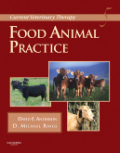
Current veterinary therapy: food animal practice
Anderson, David E.
Rings, Michael
Written by leading food animal researchers, practitioners, and educators, this comprehensive guide provides quick access to the latest medical and surgicalinterventions for cattle, sheep, and goats. The concise, quick-reference format and logical body systems organization make it ideal for use in both the clinical setting and the field. You'll easily locate key information on preventing, treating, and managing disease in food animals, as well as expert insights on improving outcomes for individual animals and herd populations. INDICE: SECTION 1: DIGESTIVE SYSTEM1. Pharyngeal lacerations and retropharyngeal abscesses in cattle2. Vesicular diseases of ruminants3. Actinomycosis and actinobacillosis4. Esophageal obstruction (choke) 5. Bloat or ruminal tympany6. Function and dysfunction of the ruminant forestomach7. Simple indigestionand secondary indigestion8. Ruminal acidosis and rumenitis9. Rumenotomy and rumenostomy10. Abomasal ulcers11. Abomasal emptying defect in sheep12. Pathophysiology of displacement of the abomasum in cattle13. Surgical considerations for management of displacement of the abomasum in cattle14. Prognostic indicators and comparison of corrective fixation techniques for displacement of the abomasum in dairy cattle15. Laparoscopic abomasopexy for correction of left displaced abomasum16. Hepatotoxicities of ruminants17. Hemorrhagic bowel syndrome18. Clostridium novyi (myconecrosis, black disease, and bacillary hemoglobinuria) and Clostridium septicum (braxy) infections19. Clostridial Enterotoxemia (Clostridium perfringens) 20. Johne's disease (paratuberculosis) 21. Neonatal calf diarrhea22. Helminth parasites of the ruminant gastrointestinal tract23. Gastrointestinal protozoal infections in ruminants24. Bovine viral diarrhea virus25. Salmonellosis26. Winter dysentery27. Duodenal obstruction 28. Trichobezoars 29. Intussusception 30. Intestinal volvulus31. Intestinal atresia32. RectalprolapseSECTION 2: METABOLIC SYSTEM33. Milk fever (parturient paresis) in cows, ewes, and doe goats34. Phosphorus deficiency35. Ruminant hypomagnesemic tetanies36. Ketosis37. Pregnancy toxemia of ewes38. Fatty liver in dairy cattle39. Clinical use of ultrasound for subcutaneous fat thickness measurements in dairy cattle40. Metabolic profile testing in dairy cattleSECTION 3: RESPIRATORY SYSTEM41. Mannheimia haemolytica- and Pasteurella multocida-induced bovine pneumonia42. Bovine respiratory disease virology 43. Mycoplasmas in bovine respiratory disease44. Sheep and goat respiratory disease 45. Diseases of the upper respiratory system in cattle, sheep, and goats46. Surgery of the upper respiratory tract47. Surgery of the thoraxSECTION 4: CARDIOVASCULAR SYSTEM48. Examination of the bovine patient with heart disease49. Congenital heart disease in cattle50. Acquired heart diseases in cattleSECTION 5: MUSCULOSKELETAL SYSTEM51.Noninfectious disorders of the foot52. Infectious disorders of the foot skin53. Surgery of the bovine digit54. Small ruminant infectious disease of the foot55. Fracture management in cattle56. Septic arthritis in cattle57. Osteochondrosis in cattle58. Ligament injuries of the stifle59. Coxofemoral luxation60. Hygroma of the carpus and tarsusSECTION 6: NEUROLOGICAL SYSTEM61. Clinical examination62. Ancillary tests63. Muscular tone and gait abnormalities64. Cranialnerve abnormalities65. Mentation abnormality, depression, and cortical blindness66. Central nervous system infection and infestationSECTION 7: URINARY SYSTEM67. Urolithiasis68. Urinary tract infection in food animals69. Neonatal urinary disorders70. Ulcerative posthitis71. Bovine enzootic hematuria72. Surgery of the urinary tractSECTION 8: GENITAL SURGERY - MALE73. Diagnosis and management of juvenile anomalies of the penis and prepuce74. Diagnosis and managementof penile deviations75. Diagnosis and management of injuries to the penis andprepuce of bulls76. Diagnosis and management of inguinal hernia in bulls77. Diagnosis and management of conditions of the scrotum and testes78. Preparationof teaser bulls, rams, and bucksSECTION 9: GENITAL SURGERY - FEMALE79. Bovinecesarean sections: risk factors and outcomes 80. Surgery of the vagina and nongravid uterus81. Umbilical surgery in calves82. Diagnosis and management of teat injury83. Laparoscopy in large animal surgerySECTION 10: OPHTHALMOLOGY84. Ophthalmic examination techniques for production animals85. Selected eye diseases of cattle86. Selected eye diseases of sheep and goats87. Ophthalmology of South American camelids: llamas, alpacas, guanacos, and vicunas88. Selected eye diseases of swine89. Food animal ocular neoplasia90. Neurogenic vision loss91. Ophthalmic therapeutics92. Enucleation in the bovineSECTION 11: PHARMACOLOGY AND THERAPEUTICS93. Ethical responsibilities of bovine veterinarians in selecting and using therapeutic drugs94. Ethical responsibilities of small ruminant veterinarians in selecting and using therapeutics95. Practical pharmacokinetics for the food animal practitioner96. The Food Animal Residue Avoidance Databank (FARAD) and related drug regulations97. Anthelmintic therapy in an era ofresistance98. Antimicrobial resistance in human pathogens and the use of antimicrobials in food animals: challenges in food animal veterinary practice99. Evidence-based veterinary medicine - therapeutic considerations100. Therapeuticoptions in organic livestock medicine101. Decision making in mastitis therapy102. Respiratory disease treatment considerations in feedyards103. Antibiotic treatment of diarrhea in preweaned calves104. Fluid therapy, transfusion, and shock therapy105. Pain management in cattle and small ruminantsSECTION 12: CHEMICAL RESTRAINT, GENERAL ANESTHESIA, AND PAIN MANAGEMENT106. Chemical restraint in ruminants107. General anesthesia in ruminants108. Managing severe pain inruminantsSECTION 13: COW-CALF/SMALL RUMINANT PRODUCTION MEDICINE109. Marketing beef cow-calf production medicine in private practice 110. Economic analysistechniques for the cow-calf practitioner111. Cow-calf operation beef quality assurance (BQA) 112. Biosecurity for cow-calf enterprises113. Management of neonatal diarrhea in cow-calf herds114. Calf preweaning immunity and impact on vaccine schedules115. Beef heifer development116. Investigation and abortion and fetal loss in the beef herd117. Addressing high dystocia incidence in cow-calf herds118. Carcass ultrasound uses in beef cattle production settingsSECTION14: FEEDLOT PRODUCTION MEDICINE119. Preconditioned calves in the feedyard120.Low stress livestock handling121. Biosecurity for feedlot enterprises 122. Use of statistical process control in feedlot practice 123. Growth promotants124. Feedlot vaccination protocols125. An economic risk assessment model for management of pregnant feeder heifers126. Investigation of lameness outbreaks in feedlot cattle127. Investigating a respiratory disease outbreak128. Feedlot therapeutic protocols 129. Managing hospital pen systems130. No loose parts necropsy procedure for the feedyard
- ISBN: 978-1-4160-3591-6
- Editorial: Saunders
- Encuadernacion: Cartoné
- Páginas: 736
- Fecha Publicación: 22/08/2008
- Nº Volúmenes: 1
- Idioma: Inglés
